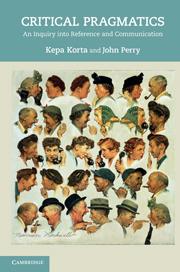Book contents
- Frontmatter
- Contents
- Preface
- Acknowledgments
- 1 Introduction
- 2 A short history of reference
- 3 Acts, roles, and singular reference
- 4 Elements of reference
- 5 Demonstratives
- 6 Context sensitivity and indexicals
- 7 Names
- 8 Definite descriptions
- 9 Implicit reference and unarticulated constituents
- 10 Locutionary content and speech acts
- 11 Reference and implicature
- 12 Semantics, pragmatics, and Critical Pragmatics
- 13 Harnessing information
- 14 Examples
- Bibliography
- Index
12 - Semantics, pragmatics, and Critical Pragmatics
Published online by Cambridge University Press: 05 March 2013
- Frontmatter
- Contents
- Preface
- Acknowledgments
- 1 Introduction
- 2 A short history of reference
- 3 Acts, roles, and singular reference
- 4 Elements of reference
- 5 Demonstratives
- 6 Context sensitivity and indexicals
- 7 Names
- 8 Definite descriptions
- 9 Implicit reference and unarticulated constituents
- 10 Locutionary content and speech acts
- 11 Reference and implicature
- 12 Semantics, pragmatics, and Critical Pragmatics
- 13 Harnessing information
- 14 Examples
- Bibliography
- Index
Summary
Introduction
In the second half of the twentieth century, two important developments in the investigation of the meaning and use of natural language pushed the concept of what is said to center stage. Kaplan, Kripke, Donnellan, and others developed a theory of reference and truth for semantics that broke with the Frege–Russell descriptivist tradition, based on arguments that the descriptivist theory gave the wrong result about what is said, with sentences involving names, indexicals, and demonstratives, and perhaps even some uses of descriptions themselves. Grice's distinction between what is said and what is meant, and Austin's related distinction between locutionary and illocutionary acts, played an important role in the development of pragmatics. Referential semantics and pragmatics, especially Gricean pragmatics, seemed complementary. Kaplan's version of what is said [Kaplan, 1989a], the concept of the content of an utterance (or a sentence in context), seemed to line up pretty closely with Grice's concept of what is said by the speaker in uttering a sentence [Grice 1967a/1989]. Speaker meaning, minus Kaplan's content, would leave what is implicated, and between content and implicature would lie the boundary between semantics and pragmatics.
A pretty picture, but it doesn't quite work. One the one hand, Kaplan's contents aren't the right input for Gricean reasoning, as we argued in the last chapter. For another, Gricean reasoning seems to be required in a number of cases of ‘semantic indeterminacy’ to arrive at what is said, in the intuitive sense that stands behind Kaplan's theory.
- Type
- Chapter
- Information
- Critical PragmaticsAn Inquiry into Reference and Communication, pp. 139 - 149Publisher: Cambridge University PressPrint publication year: 2011
- 1
- Cited by



